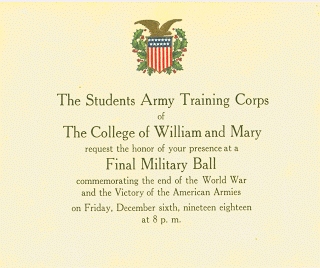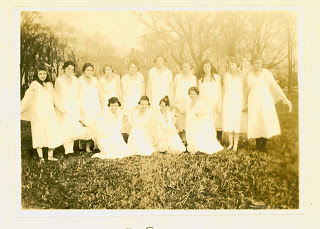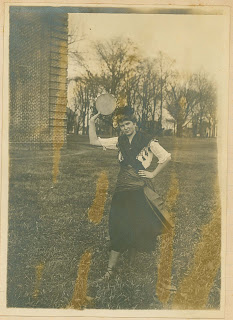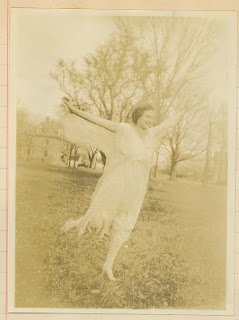December 20, 2008
December 1918: Winter Break
December 6, 2008
December 6, 1918: SATC Military Ball
 Less than a month after the end of World War I, the Students' Army Training Corps (SATC) at William and Mary disbanded. On December 6, 1918, family, friends, students, and faculty were invited to an open house at the Corps' barracks and then to a parade review and ceremony at the athletic field. The day ended with the SATC Final Military Ball, "commemorating the end of the World War and the victory of the American Armies." The Virginia Gazette referred to the dance as a "celebration of the S.A.T.C. [that] will long be remembered by William and Mary boys, and will will mark a unique period in the history of the old college."
Less than a month after the end of World War I, the Students' Army Training Corps (SATC) at William and Mary disbanded. On December 6, 1918, family, friends, students, and faculty were invited to an open house at the Corps' barracks and then to a parade review and ceremony at the athletic field. The day ended with the SATC Final Military Ball, "commemorating the end of the World War and the victory of the American Armies." The Virginia Gazette referred to the dance as a "celebration of the S.A.T.C. [that] will long be remembered by William and Mary boys, and will will mark a unique period in the history of the old college."[...] the greatest part of the celebration remained for the evening, when the formal military ball, the principal social affair of the military organization, was held in the Mess Hall. It had been planned a considerable time in advance, and all members of the command attended and brought partners. In addition to the young ladies of the college, many attended from Williamsburg, Richmond, Norfolk, Washington and other cities. Many of the soldiers had their sweethearts from a distance to attend. The whole affair was so well organized and conducted that a more successful one would have been rare indeed. The walls, chandeliers, trimmings, and furnishings of the large hall were lavishly decorated with the national colors in various designs of presentment, all of which was pleasingly illuminated by the brilliant colored lights.
The guests assembled at 8 o’clock, the ladies wearing the latest creations of evening dress and the men all wearing their dress military uniforms. [...]
At 10 o’clock there was an intermission of a few minutes, during which a neat little cap, called the “Liberty Cap” by the guests designed and made especially for the occasion, was issued to each lady present, and was worn by her during the remainder of the evening.
Not the least element in the evening’s jocund entertainment was the bounteous supply of punch and other refreshments. May the reader not inquire what the punch was made of. [...]
The final dance was announced by the bugle call for taps and came to a close exactly at 1:25 o’clock in the morning. The out-of-town guests were entertained by friends at the college and in Williamsburg.
This post was composed by Kate Hill.
For additional information about the first women students at the College of William and Mary see: When Mary Entered with her Brother William: Women at the College of William and Mary, 1918-1945 by Laura F. Parrish; "The Petticoat Invasion": Women at the College of William and Mary, 1918-1945; The Martha Barksdale Papers; and the Women at the College of William and Mary page on the Special Collections Research Center Wiki.
November 26, 2008
November 26, 1918: First Days at William and Mary
One of the first women students to enroll at the College of William and Mary, Martha Barksdale kept a journal during the first year of co-education. What follows is the first entry from her journal.
Nov. 26, 1918.
Today has been so wonderful that I must begin my book here and go back to catch up past events.
Yesterday evening Florence Harris, our beloved first student government president announced her resignation on account of the fact that she was leaving school for family reason[s]. I think she has to take care of her little brothers.
This evening I was elected president of our Student Government with a nomination of fourteen to four. I certainly appreciate the honor, probably the greatest I have ever had. But I dread the responsibility.
After many controversies and much worry this summer, I decided to come to Wm. and Mary, this first year of its coeducation. I do not now regret my choice.
I arrived here on Sept. 19, and came up in an automobile with Ruth Conkey and Celeste Ross. After several days we got straight and had classes one day before we were quarrantined [sic] for Spanish influenza.
This was a good thing for us. None of the girls had it so we used our time in getting well acquainted. We had met none of the boys and the quarantine served to make them want to meet us.
One evening we had a match game of basket ball to cheer Miss Gatling and incidentally ourselves. Celeste and Florence were the capitans [sic]. I played jumping center by boys' rules against Louise Reid and shot the first and only goal thus winning the game for our side. This started my basket ball "rep" here, and I only hope I can keep it at its present glow.
Soon after the quarrantine [sic] the Lieutenants and a few non-coms came over one night. This started our social hour. Since then the boys come over everynight[sic] after supper until call to quarters or on Sat. and Sunday until 10:00. I have met some very nice boys but don't enjoy it much because dancing has been the chief amusement.
One event that has amused me very much and annoyed me at the time was the water throwing affair. Mr. Simmons, Mr. Elliott, and Mr. Lyons are seniors here. They decided to calm some ducks [freshmen] who were singing under their windows so [they] threw out a bag of water. The bag hit the fire escape and drenched the all important Capt.Van Dusen and Lieutenant Taylor. They were furiously angry and stirred up quite a commotion over it. A few days later the whole S.A.T.C. lined up and marched Lyons and Simmons to the depot to ship them. Dr. Clark, Prof. Keeble, and others succeeded in making Capt. Van Dusen have them brought back. The girls were very indignant over this affair, especially Catherine.
On Hallowe'en night we had quite an enjoyable party.
I made there [sic] with John Chappell, the first boy here with whom I've been real friends.
Through John, ("Jack"), I met W. Saunders. I learned not to trust mankind through my intercourse with him. Was it because he did not respect me or just his nature?
In here comes a comical incident which I shall not put down in so public an affair as this book but simply a card to recall an amusing day, the day the armistice was signed.
Two weeks after this date I spent a very pleasant Sunday. Sergeant Day came up to see me, and quite unexpectedly Lewis also. I was glad because Lewis seemed to like Day very well. Lewis spent the night in town.
We went to the M.E. Church that night, and I cut Educ. and French to see him off the next morning.
Another event straggles in along here somewhere - our dancing exhibition. Miss Gatling took great pains to teach us some folk and other dances. We did the folk dances in our regular "gym" out fit [sic] and the fancy dances in Grecian costume. My ballet slipper came untied during the first step of one of the dances and I was miserable for a while but didn't fall over it.
In the "Garland Dance" we had garlands made of ivy off the Library. W. Saunders helped me make mine. We decorated the "gym" with honeysuckle from near the monument.
Lest we forget the first box of candy I received at W&M from Lewis on that memorable Sunday, Nov. 3, 1918, when I entertained a Sailor and a Soldier. Shall I ever forget the stares Lewis and I got from the S.A.T.C.'s? No, never.
In memory of my first roommate at college - up to this time my last - except for Janet on Special occasion and my beloved "Pal" sometimes.
We had lots of fun in basketball games. The Orange and Black fought many "peppy" battles. The Orange won two out of the three championship games, also the last one before X-mas. Keep the good work up Orange!
Soon after peace was made the S.A.T.C. began to talk of disbanding. They planned a big dance in the dining Hall here for the last night. I not being a dancer and not being popular was left out.
A number of girls from all over the state came. One Annette Pruden roomed with Ruth Harris across the hall from me. She seemed to be very nice.
She was in my room when Janet hid in the closet then came out looking so cheap. She heard us planning the party at Janet's.
--From the diary of Martha Barksdale available in the Special Collections Research Center.
November 23, 2008
November 23, 1918: From the Diary of Martha Barksdale
For additional information about the first women students at the College of William and Mary see: When Mary Entered with her Brother William: Women at the College of William and Mary, 1918-1945 by Laura F. Parrish; "The Petticoat Invasion": Women at the College of William and Mary, 1918-1945; The Martha Barksdale Papers; and the Women at the College of William and Mary page on the Special Collections Research Center Wiki.
November 23, 1918: Dance Recital
Women's gymnasium class in costume
bottom row, l-r: Ruth Conkey, Margaret Thornton, Hope Baines, Evelyn Palmer
Editions of The Colonial Echo and Catherine Dennis' scrapbook are available in the Special Collections Research Center.
This post was composed by Kate Hill.
For additional information about the first women students at the College of William and Mary see: When Mary Entered with her Brother William: Women at the College of William and Mary, 1918-1945 by Laura F. Parrish; "The Petticoat Invasion": Women at the College of William and Mary, 1918-1945; The Martha Barksdale Papers; and the Women at the College of William and Mary page on the Special Collections Research Center Wiki.
November 11, 2008
November 11, 1918: End of World War I
The sun had long since set behind the western hills and all the world was hushed. The silence seemed to foretell of some momentous event. The atmosphere, even in the deadly silence, seemed to ring with excitement. Suddenly there burst forth a blasting of horns, blowing of whistles, ringing of bells, firing of guns, beating of drums, and on every hand torches leaped into flame.
A makeshift parade full of joy and national symbolism reportedly then marched through the streets of Williamsburg, culminating in a bonfire on campus.
November 3, 2008
November 3, 1918: From the Diary of Martha Barksdale
For additional information about the first women students at the College of William and Mary see: When Mary Entered with her Brother William: Women at the College of William and Mary, 1918-1945 by Laura F. Parrish; "The Petticoat Invasion": Women at the College of William and Mary, 1918-1945; The Martha Barksdale Papers; and the Women at the College of William and Mary page on the Special Collections Research Center Wiki.




